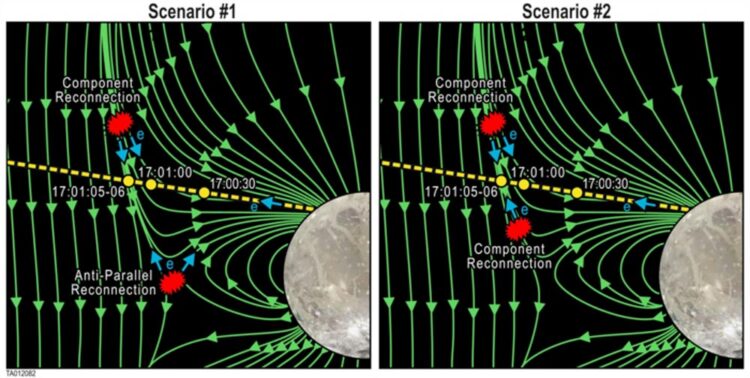Evidence for magnetic reconnection between Ganymede and Jupiter

In June 2021, NASA’s Juno spacecraft flew close to Ganymede, Jupiter’s largest moon, observing evidence of magnetic reconnection. An SwRI-led team used Juno data to characterize the magnetic topology and electron flow direction for two different reconnection scenarios at Ganymede’s magnetopause. The yellow dashed line indicates Juno’s trajectory.
Credit: SwRI/Jia et al. (2008)
Juno spacecraft discovered magnetospheric fireworks as magnetic field lines merge and snap between the gas giant and its largest moon.
In June 2021, NASA’s Juno spacecraft flew close to Ganymede, Jupiter’s largest moon, observing evidence of magnetic reconnection. A team led by Southwest Research Institute used Juno data to examine the electron and ion particles and magnetic fields as the magnetic field lines of Jupiter and Ganymede merged, snapped and reoriented, heating and accelerating the charged particles in the region.
“Ganymede is the only moon in our solar system with its own magnetic field,” said Juno Principal Investigator Dr. Scott Bolton of SwRI. “The snapping and reconnecting of Ganymede’s magnetic field lines with Jupiter’s creates the magnetospheric fireworks.”
Magnetic reconnection is an explosive physical process that converts stored magnetic energy into kinetic energy and heat. Ganymede’s mini magnetosphere interacts with Jupiter’s massive magnetosphere, in the magnetopause, the boundary between the two regions.
“We interpreted the presence of accelerated electrons traveling along the magnetic field at Ganymede’s magnetopause as evidence that magnetic reconnection was occurring there during the Juno flyby,” said Dr. Robert Ebert, lead author of a Geophysical Research Letters paper describing the findings. “These observations further support the notion that magnetic reconnection at Ganymede’s magnetopause can be a driver of dynamic processes in the local space environment around this moon of Jupiter.”
The SwRI-developed Jovian Auroral Distributions Experiment (JADE) aboard Juno observed enhanced electron fluxes, including accelerated, magnetic field-aligned electrons. Reconnection as observed by Juno is thought to be related to the generation of Ganymede’s aurora.
“The accelerated electrons observed by JADE are similar to those observed by NASA’s Magnetospheric Multiscale (MSS) spacecraft during reconnection at the Earth’s magnetopause,” said Dr. Stephen Fuselier, a co-author of the paper. “That’s one of the exciting results from the Ganymede flyby: Despite the vast differences between Ganymede and Earth, we find commonality in the universal process of magnetic reconnection.”
During the Juno flyby, the SwRI-led Ultraviolet Spectrograph (UVS) observed Ganymede’s auroral emissions, which are expected to be produced by electrons accelerated via magnetic reconnection. SwRI has built two additional UVS instruments to operate in Jupiter orbit aboard ESA’s JUpiter ICy moons Explorer (JUICE) spacecraft and NASA’s Europa Clipper. The European Space Agency’s JUICE mission is scheduled to launch in April 2023 and arrive at Jupiter in 2031. NASA’s Europa Clipper is scheduled to launch in October 2024 and arrive at Jupiter in 2030.
“Nothing is simple — or small — when you have the biggest planet in the solar system as your neighbor,” said Thomas Greathouse, a Juno scientist from SwRI. “This was the first measurement of this complicated interaction at Ganymede. This gives us a very early tantalizing taste of the information we expect to learn from ESA’s JUICE mission.”
A paper describing this research was published in Geophysical Research Letters and can be accessed at https://agupubs.onlinelibrary.wiley.com/doi/10.1029/2022GL099775.
For more information, visit https://www.swri.org/planetary-science.
Journal: Geophysical Research Letters
DOI: 10.1029/2022GL099775
Method of Research: Observational study
Subject of Research: Not applicable
Article Title: Evidence for magnetic reconnection at Ganymede’s upstream magnetopause during the PJ34 Juno flyby
Article Publication Date: 12-Dec-2022
Media Contacts
Cecilia Novak
Southwest Research Institute
cecilia.novak@swri.org
Deb Schmid
Southwest Research Institute
dschmid@swri.org
Office: 210-522-2254
All latest news from the category: Physics and Astronomy
This area deals with the fundamental laws and building blocks of nature and how they interact, the properties and the behavior of matter, and research into space and time and their structures.
innovations-report provides in-depth reports and articles on subjects such as astrophysics, laser technologies, nuclear, quantum, particle and solid-state physics, nanotechnologies, planetary research and findings (Mars, Venus) and developments related to the Hubble Telescope.
Newest articles

Innovative 3D printed scaffolds offer new hope for bone healing
Researchers at the Institute for Bioengineering of Catalonia have developed novel 3D printed PLA-CaP scaffolds that promote blood vessel formation, ensuring better healing and regeneration of bone tissue. Bone is…

The surprising role of gut infection in Alzheimer’s disease
ASU- and Banner Alzheimer’s Institute-led study implicates link between a common virus and the disease, which travels from the gut to the brain and may be a target for antiviral…

Molecular gardening: New enzymes discovered for protein modification pruning
How deubiquitinases USP53 and USP54 cleave long polyubiquitin chains and how the former is linked to liver disease in children. Deubiquitinases (DUBs) are enzymes used by cells to trim protein…


